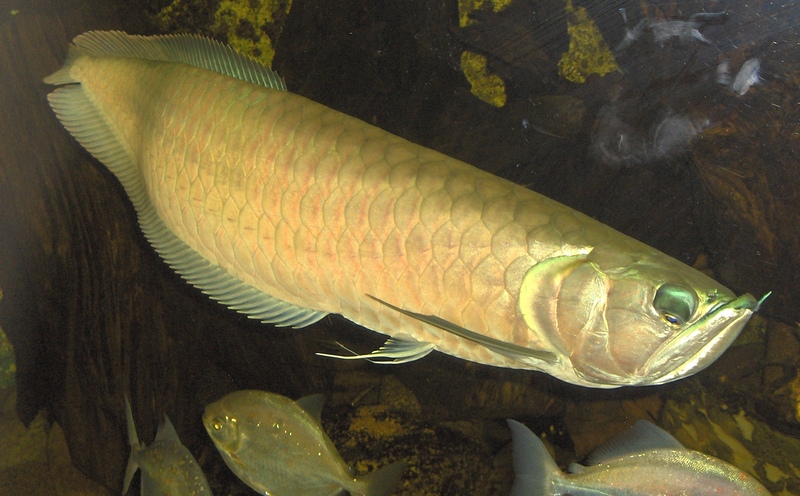|
Silver Arowana (Osteoglossum bicirrhosum) - Wiki
| 제목: | Silver Arowana (Osteoglossum bicirrhosum) - Wiki
| |

| 해상도: 2108x1308
파일크기: 968883 Bytes
촬영일: 2005:07:09 12:01:34
사진기: HP PhotoSmart R507 (V01.00)+ (Hewlett-Packard)
F number: f/3.0
Exposure: 1666/100000 sec
Focal Length: 740/100
등록시간: 2006:11:28 22:04:46
|
Silver arowana
From Wikipedia, the free encyclopedia
[Photo] Image of Osteoglossum bicirrhosum, taken by User:Qwertzy2.
The silver arowana, Osteoglossum bicirrhosum, sometimes spelled arawana, is a freshwater bony fish of the family Osteoglossidae, commonly kept in aquaria. The term "Osteoglossum" means "bone-tongued" and "bicirrhosum" means "two barbels" (from the Greek language).
Description
This species is found in is the Amazon River basin and in the Rupununi and Oyapock Rivers in South America as well as in still waters in Guyana.
This fish has relatively large scales, a long body, and a tapered tail, with the dorsal and anal fins extending all the way to the small caudal fin, with which they are nearly fused. It can grow to a maximum size of around 1 m (39 inches) in captivity. In the wild, it has been known to reach over 1.2 m (47 inches) in length. The juveniles are usually a dull silver color with black markings around the head and the tail. Once they reach about 15 cm (6 inches), the markings will disappear and they will start to obtain the silvery color that give them their common name.
The species is also called monkey fish because it of its ability to jump out of the water and capture its prey. It usually swims near the water surface waiting for potential prey. Although specimens have been found with the remains of birds, bats, and snakes in their stomachs, its main diet consist of crustaceans, insects, smaller fishes and other animals that float on the water surface, on which its draw-bridge-like mouth is exclusively adapted for feeding.
Arowanas are sometimes called Dragon Fish by aquarists because their shiny armor-like scales and double barbels are reminiscent of descriptions of dragons in Asian folklore.
Conservation status
The Silver Arowana is currently not listed on any CITES appendix [1] nor on the 2004 IUCN Red List [2]. It is one of the most popular ornamental fish from South America, however, and therefore its conservation status merits attention. [3] It is often kept as a pet as a substitute for the Asian arowana, which is listed on CITES Appendix I and is therefore difficult and expensive to obtain legally.
Keeping Silver Arowanas as aquarium fish
Aquarium
To keep one of these large fishes, a large enough aquarium is important. The minimum tank size for one adult Silver Arowana is 200 cm (72 inches) x 66 cm (24 inches) x 66 cm (24 inches), or approximately 180 gallons. A young specimen can be kept in a smaller tank, but as it grows a larger tank will be necessary to prevent deformities and to ensure the maximum length and life span of the animal.
Any aquarium housing an arowana should be tightly covered because of these fishes' jumping behavior.
Water Conditions
Water conditions are important for arowanas. Strong filtration is necessary for these large carnivores. Commercially available black water additives can help simulate the Silver Arowana's natural habitat, although they can adapt to most water supplies and thrive. A 25-30% water change, siphoning waste and other detritus, is necessary 1-2 times every week to maintain excellent water conditions. The water temperature should range from 24°C (75°F) to 28°C (82°F), with the ideal about 26°C (79°F).
Feeding
Young Silver Arowanas should not be overfed, because according to some hobbyists, they can develop dropeye, a condition in which the eyes are turned downward, as they grow. Arowanas should be offered meaty foods such as insects, shrimp, fish, beef heart, frogs, pellets, etc. Many aquarists recommend against live feeder fish because these are often raised in poor conditions and are capable of transmitting diseases to predatory fish; additionally, an arowana may eventually refuse to eat anything else but feeder fish which could prove to be very expensive. Mealworm exoskeletons are sometimes difficult for young arowanas to digest, so they are best avoided.
Tankmates
Silver Arowanas can be kept with other freshwater fish as long as they are too large to fit in the arowana's mouth and can tolerate the arowanas active-swimming lifestyle. Many people like having more than one Arowana in the tank; in this case, hobbyists recommend keeping at least 5-6 in the tank at a time because Silver Arowanas are very aggressive towards each other.
References
Osteoglossum bicirrhosum (TSN 161894). Integrated Taxonomic Information System. Accessed on 19 March 2006.
"Osteoglossum bicirrhosum". FishBase. Ed. Ranier Froese and Daniel Pauly. 3 2006 version. N.p.: FishBase, 2006.
Dawes, John; Chuan, Lim Lian; & Cheong, Leslie, eds (1999). Dragon Fish, The. Kingdom Books England.
Retrieved from "http://en.wikipedia.org/wiki/Silver_arowana"
| The text in this page is based on the copyrighted Wikipedia article shown in above URL. It is used under the GNU Free Documentation License. You may redistribute it, verbatim or modified, providing that you comply with the terms of the GFDL. |
|
^o^
동물그림창고 똑똑전화 누리집
^o^
|
|

